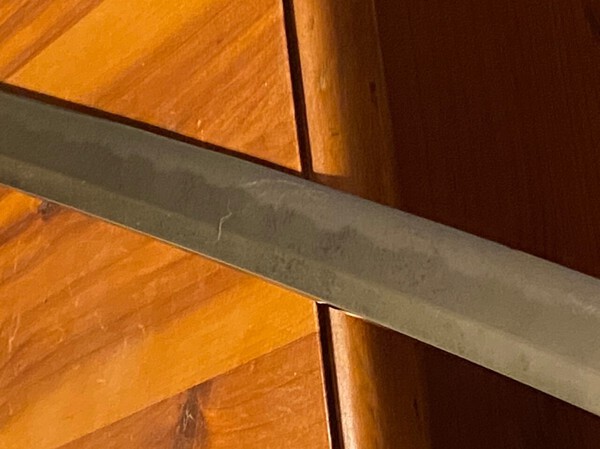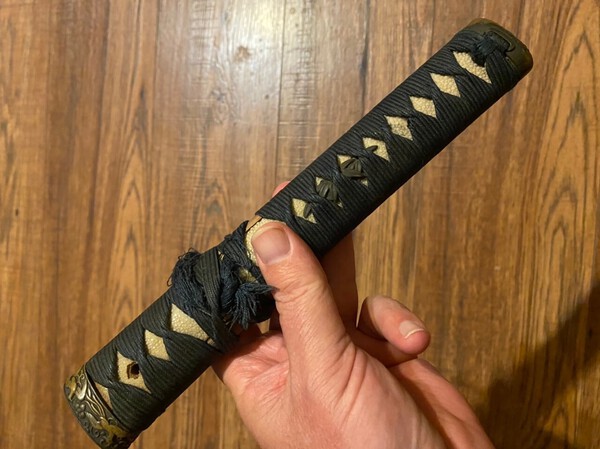
75Corvette
Members-
Posts
30 -
Joined
-
Last visited
Content Type
Profiles
Forums
Events
Store
Downloads
Gallery
Everything posted by 75Corvette
-
First post, first sword.. need a translation.
75Corvette replied to 75Corvette's topic in Translation Assistance
Very cool! I wondered if it had a "religious" type meaning vs monetary.. R Jamie -
First post, first sword.. need a translation.
75Corvette replied to 75Corvette's topic in Translation Assistance
Wow! That is the same kanji that came up as "profit" .... R jamie -
First post, first sword.. need a translation.
75Corvette replied to 75Corvette's topic in Translation Assistance
I get it... I keep coming up with "profit" and I'm pretty sure that's not right.. Thank you. Jamie -
First post, first sword.. need a translation.
75Corvette replied to 75Corvette's topic in Translation Assistance
I would like to thank everyone for their time and efforts.. please excuse the lack of personal thank you's. As I am still figuring out the art of forum posts.. As I have done years of research into topics and areas of my own.. please know that I understand the value of time and effort. Mostly the patience in translating my questions! I am working on my vocabulary.. as well as learning Kanji. VR jamie -
First post, first sword.. need a translation.
75Corvette replied to 75Corvette's topic in Translation Assistance
Bruce Does this symbol/kanji mean anything? At first, I thought it was part of the design.. but now seeing it as something else. R jamie -
First post, first sword.. need a translation.
75Corvette replied to 75Corvette's topic in Translation Assistance
Great insight! Thank you -
First post, first sword.. need a translation.
75Corvette replied to 75Corvette's topic in Translation Assistance
Interesting.. It would be cool to see what and how they (leather wraps) were used, with the civilian fittings. I've only seen them with the gunto swords/fitting/colors. I'm still trying to find the reason for the difference in "signature, makers name" .. as the mid and lower section of the top kanji, are different. Extra vertical line -mid and VV vs AV (hashes) on the bottom. - seems like that would be a different name. Thank you Jamie -
First post, first sword.. need a translation.
75Corvette replied to 75Corvette's topic in Translation Assistance
Thank you... that helps a great deal! R Jamie -
First post, first sword.. need a translation.
75Corvette replied to 75Corvette's topic in Translation Assistance
These two "signatures" are allegedly from the same person.. though it is noted that "this" Kaneshige, is not the same Kaneshige. Special feature:Kaneshige was a sword smith who flourished during the war in Chiba prefecture, but this Kaneshige is supposed to be a different person. This work has the same named Mei and in Navy Koshirae, but we judge this to be made by different Kaneshige. This is the question of writing styles.. is it normal to have such a difference in the Kanji markings from the "same" smith in the same year, on the same product? VR Jamie -
First post, first sword.. need a translation.
75Corvette replied to 75Corvette's topic in Translation Assistance
-
First post, first sword.. need a translation.
75Corvette replied to 75Corvette's topic in Translation Assistance
Makes more sense, as my previous research was into old pottery. -
First post, first sword.. need a translation.
75Corvette replied to 75Corvette's topic in Translation Assistance
Not now... as I stopped the spread of rust, and eventual ruin. Sadly I can't account for the years of neglect and mistreatment... but now that I have it.. it will stay clean and respected. As with the other antiquities I care for in my house.. -
First post, first sword.. need a translation.
75Corvette replied to 75Corvette's topic in Translation Assistance
Pretty sure the writing style changed through the years... as other experts had to use the writing style to figure out what period the piece was made. As well as the examples of particular signature of this smith. -
First post, first sword.. need a translation.
75Corvette replied to 75Corvette's topic in Translation Assistance
Which part are you disagreeing with? -
First post, first sword.. need a translation.
75Corvette replied to 75Corvette's topic in Translation Assistance
Yes, I would imagine so... but since I'm being told it's a 1942 tourist blade, mistreated and of little to no value. I guess I'm safe.. my fingers will be hard as nails. where can I find sources of kanji styles through time.. as I see the sword makers name is used through the centuries.. and changes a bit. This is helping greatly! thank you. R Jsmie -
First post, first sword.. need a translation.
75Corvette replied to 75Corvette's topic in Translation Assistance
Thank you for the link! I will dive into that.. you are very correct in what you are saying.. as to what I can see in my hands. Exact traditional part names.. I'm still working on! In depth analysis of antique metal and weapons,, I'm pretty good at. Shows no sign of the leather covering.. just older than 1942 civilian fittings.. loosing its traditional sash wrap and hanger, for the single wartime clip mount.. The leather covers seem to fit the metal scabbards.. at least with the 4-5 I've examined. When the blade was examined prior to me.. the answer was, early-mid 1800's blade with original fittings.. converted to wartime use and marked as such. NOT a rare or very old blade, no famous maker, likely some low level village politician. - Only thing "special" was not being machine made war blade.. and having real pre war fittings (except for the hanger) my joy is in the polishing work I've done myself.. and having it re-wrapped in old silk, keeping it as found.. just clean and functional. With 100 hours or so of my own work into it. It was a joy to see the hamon show up as I polished away.. and the grain of the steel. Won't be a show winner, as it has a few nicks and such.. and I'm not paying $100 an inch to polish it with gypsy spit and fairy dust. Just lots of light oil and very fine paper. Needless to say, with this sword being what it is.. the way it is, I'm getting a good amount of research done, that I didn't intend to do... as it raises so many questions. VR Jamie -
First post, first sword.. need a translation.
75Corvette replied to 75Corvette's topic in Translation Assistance
This leads to a few more questions.. - Did civilian blades get marked with Seki when accepted into military use? - Am I not seeing a folded blade grain with hamon after, hours of polishing.. being what is showing up better, as I remove the oxidation? -- Any explanation for old civilian fittings, fitted to this blade.. and modified to single military hanger, on a (Seki blade) that made to look like a traditional blade, for the WWII war effort? This is what has me very confused. VR jamie - here is what I started with. the other pictures above.. are all of this sword. -
First post, first sword.. need a translation.
75Corvette replied to 75Corvette's topic in Translation Assistance
And I greatly appreciate all the help, and explanations. R Jamie -
First post, first sword.. need a translation.
75Corvette replied to 75Corvette's topic in Translation Assistance
-
First post, first sword.. need a translation.
75Corvette replied to 75Corvette's topic in Translation Assistance
-
First post, first sword.. need a translation.
75Corvette replied to 75Corvette's topic in Translation Assistance
-
First post, first sword.. need a translation.
75Corvette replied to 75Corvette's topic in Translation Assistance
-
First post, first sword.. need a translation.
75Corvette replied to 75Corvette's topic in Translation Assistance
Is this stating it was made in 1942, or modified in 1942... as I was told by a shop who examined it. The punched vs drilled hole, hamon, folded blade in modified civilian mounts? This where I'm finding my confusion... VR jamie -
First post, first sword.. need a translation.
75Corvette replied to 75Corvette's topic in Translation Assistance
























